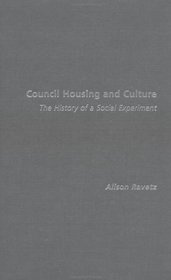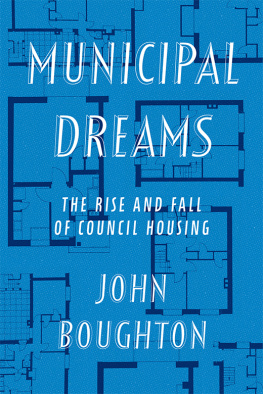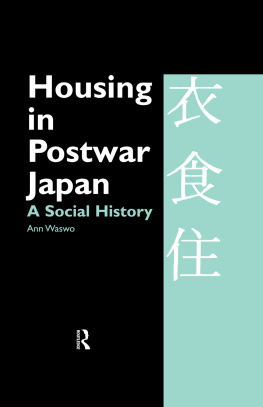Acknowledgements
Thanks are due to the Nuffield Foundation who supported the early stages of research for this book through a Social Science Research Fellowship held by the author 1989-90.
Kind permission to reproduce illustrations has been given as follows:
The Architects Journal: pages 68 and 148
Broadwater Farm Youth Association: page 222
Collection of Dr Richard Turkington: pages 140 and 143
Collection of Wilf Dyson: page 168
Watling Community Association: pages 140 and 143
(The Watling Resident is housed at The Local Studies & Archive Centre, London Borough of Barnet).
Chapter Eight
The Management of Council Housing
'All the assumptions of housing policy in the past have depended upon an image of grateful recipients who pay the rent but don't dream of making their own imprint on the fully-finished, fully-serviced (according to the standards of the day) housing.'
Colin Ward, Talking Houses, 1990
The Task of Council Housing Management
In contrast to all the effort that went into its design, little thought was given to what the management of council housing would involve. Like the construction of the dwellings, this was left to local authorities, and the fact that it was almost a completely new role for them was something that many, including the journal Housing , were nervous about. Central government guidance and control, however, were surprisingly small. Some discussion of problems, with recommendations, was offered by a special subcommittee of the Central Housing Advisory Committee (CHAC), which published two reports on the management of estates in 1938 and 1945, and a number more dealing with special aspects of management through the 1950s. But the management responsibilities of authorities were not regulated by central government, and in many cases it was years before they set up special departments of housing. Of fifty-seven consulted by CHAC in 1959, only twenty-seven had a separate housing department; eight had a housing manager without a department or section, and eleven still had no housing managers at all.1 Even in the 1980s some small authorities still had no special department for housing.
The only precedents that might have been useful to the new local authority landlords were the model villages and philanthropic trusts, but there seems to have been little if any effort to consult these to see if their experience was relevant. There was however one obvious link, in the Octavia Hill school of management, which was already widely used in philanthropic housing. Although she had explicitly refrained from turning her method into anything as firm as a system, by the time of her death in 1912, Hills style of management had been adopted by Manchester and the large Scottish cities, as well as widely in Europe. Her trained workers were later appointed to manage the munitions estates, and they were only now withdrawing from these, to make way for men returning from the war. It would, then, have been a natural progression for council housing to adopt her management method, and some inroads were in fact made with a report on housing management by the womens section of the GCTPA in 1920, and by a book on House Property and its Management by Edith Neville, which was circulated to local authorities. By 1921 a number of districts were employing women managers on Addison estates, and in the later 1920s Chesterfield and Rotherham appointed Hill trained workers. The 1938 CHAC report on management recommended the method (which it praised the city of Amsterdam for using) and by this time about half of all such managers were working for local authorities, although covering less than 5 per cent of their stock in total.
But a number of things militated against the wholesale adoption of the Hill style of management. The most obvious one was scale. The method was expressly designed to work on a small scale - the optimum size of estate for a manager was supposed to be not more than 300 units. Given that within a few years some estates grew to 2000 dwellings or more, it is easy to see why the Hill method would have been thought impossibly impractical, although ironically a much later study of housing management called for a return to local management on something very like the Hill scale.2
It was not only scale, however, but the institutional organization of management that ultimately ruled out the Hill approach. Local authorities already had departments that would naturally regard certain aspects of estate management as their own preserve, including treasurers, surveyors, borough engineers and works departments. An obvious strategy was to parcel out responsibilities between them so that: the clerk commonly dealt with lettings and tenancy matters, the treasurer with rent collection, and the engineer or surveyor with maintenance.3 This left welfare of tenants out of the picture or, if in it, in an isolated position that would naturally be assigned to women. Women managers did in fact fight their corner, in spite of the engrained prejudice against women professionals at a time when, amongst others things, they were expected to give up their careers on marriage. An Association of Women House Property Managers had formed in 1916, with its own certificated training scheme. Eventually there emerged a Society of Women Housing Estate Managers (SWHEM) in 1932. Borrowing elements from the training of both sanitary inspectors and the Institute of Chartered Surveyors, they were able to take some pride in the breadth and rigour of their training. But the male-female divide bedevilled the slowly emerging profession of management. An Institute of Housing, which was predominantly though not exclusively male, had formed in 1931. Like SWHEM, it was asked to give evidence to CHACs housing subcommittee when this was set up in 1935, and after some years of overlap of memberships there was an outright schism between the two bodies in 1936.
In fact, neither one was in a strong professional position at this time, and it was a further generation before a unified profession was established. The Institute grew during the 1940s, when there was a great demand for trained staff, and this made SWHEM consider whether or not to admit men to their society. This they eventually did in 1948, in the face of strong reservations on the part of some of their - mainly older - members. There was then slow progress towards full amalgamation, the principal impediment on the Institutes side being the continuing association of SWHEM with womens issues and welfare, while for its part SWHEM feared that a merger would lower their high standards and make it easy for men to jostle women aside. The merging of the two bodies was eventually achieved in 1965 - that is, long after the practices of council housing management were firmly set.
By this time the huge postwar expansion of council housing had enhanced the status of housing departments and management, and SWHEMs fears were more or less justified. The highest posts tended to be taken by men, while the position of women managers deteriorated. The hard or technical functions were identified with male managers, as welfare was with women; and the latter was regarded, not as central to the management and wellbeing of the whole sector, but rather an added on function of management, to be used in special cases or crises. It had been the Institutes view in the 1930s that every estate should have a woman welfare worker, who would be able to teach such things as cleanliness or give homely hints such as the making of curtains.4 CHAC also, though it grasped the essence of Hills approach perfectly well, emphasized that welfare was naturally a womens function. In slum clearance, for example, it was women rather than men who had the skills to convert families to the right frame of mind for consenting to the cleansing of bedding and furniture and the destruction when necessary of vermin-infested articles.5 It was women again who could best get access to the housewife who was mainly concerned with ordering the household and who bears the brunt in times of sickness or adversity, while the husband had other preoccupations -his work, his hobbies, his weekend sport.6
Next page






